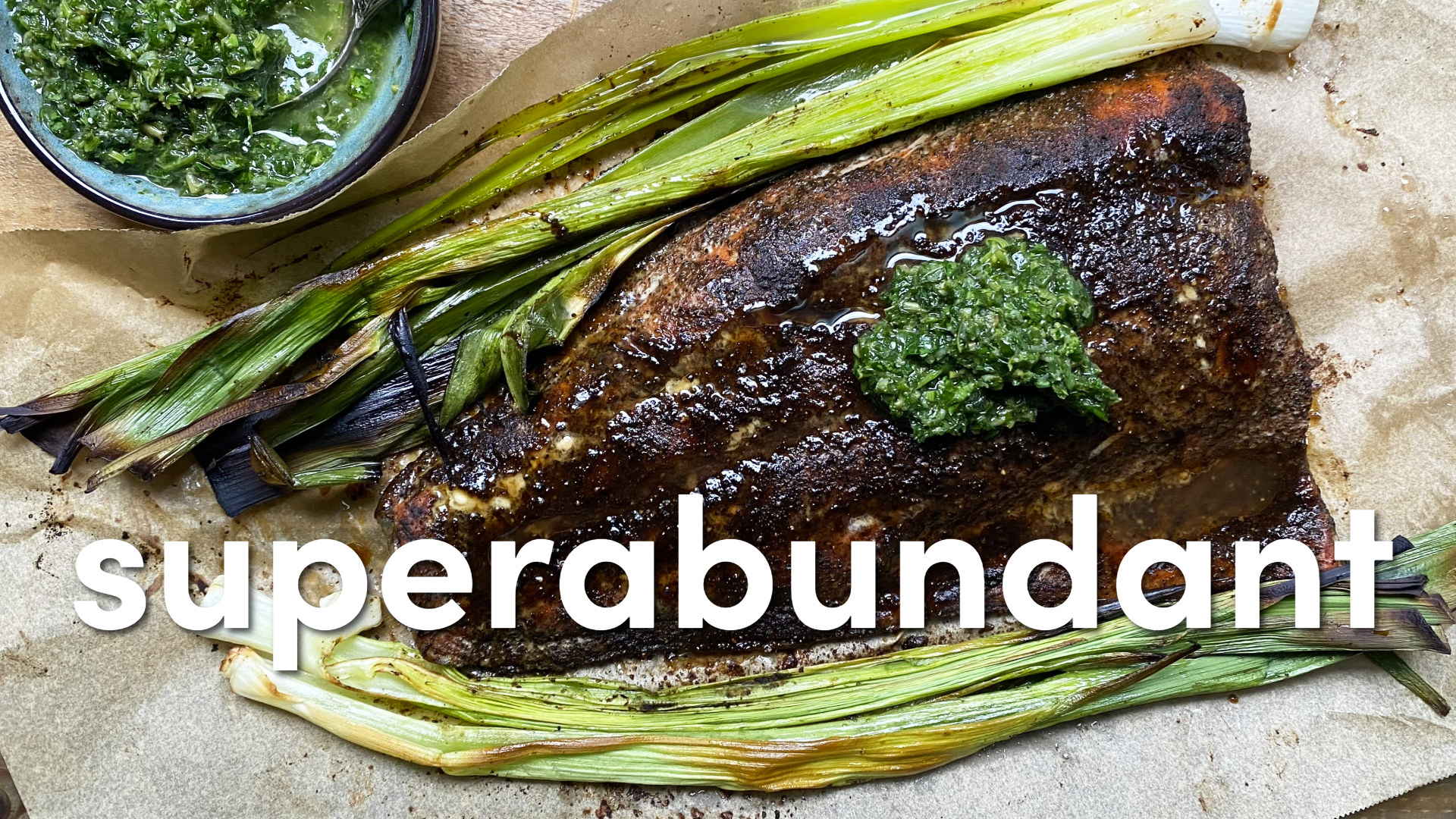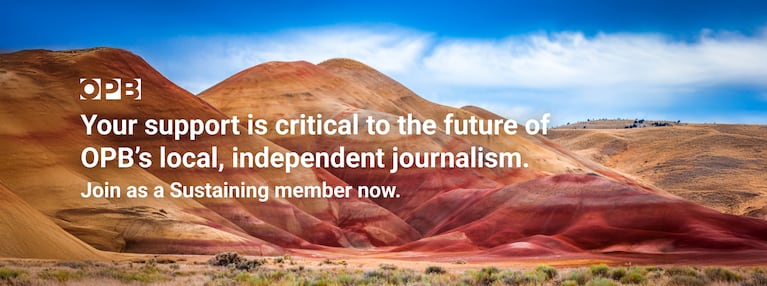OPB’s “Superabundant” explores the stories behind the foods of the Pacific Northwest with videos, articles and this weekly newsletter. To keep you sated between episodes, Heather Arndt Anderson, a Portland-based culinary historian, food writer and ecologist, highlights different aspects of the region’s food ecosystem. This week she offers a new episode and a recipe for coffee-rubbed salmon with charred leeks and chimichurri.
Click here to subscribe. For previous stories, go here.

Because we have a new “Superabundant” episode celebrating coffee AND find ourselves at the usual time of the First Salmon feast, this week we’re paying homage to both in one recipe (don’t worry, it’s not a sockeye latte). Salmon culture has existed in the Northwest since the arrival of the first humans more than a dozen millennia ago, whereas coffee culture is quite a bit more recent. But Oregon’s coffee history is still noteworthy — for example, a Portland coffee chain opened the world’s first coffee drive-thru — do you know what it was called? Read on to find out!
Coffee, salmon, farm declines and good things in markets and gardens
Wake up! It’s time for a new “Superabundant” episode
Coffee isn’t exactly a local crop, but the Northwest has certainly made it part of the cultural landscape. In every other step of the process — from roasting and brewing to styling with artful foam — the Northwest is a global leader, going way, way beyond Starbucks and Stumptown. In the latest episode of “Superabundant,” we explore why Pacific Northwest coffee culture reigns supreme.
First Salmon Feast
A beautiful photo gallery from the Confluence Project gives us a glimpse into the First Salmon Feasts that were held at Celilo Village every year in mid-April prior to 1957, when the U.S. Army Corps of Engineers smothered Celilo Falls with the Dalles Dam. Like other Indigenous Northwesterners do throughout the year, plateau tribal members still pay tribute to the salmon with a ceremony heralding the return of the fish each spring.
Listen to “The Evergreen” podcast’s recent salmon episode and watch the history of Celilo Falls on Oregon Field Guide
🎶 “...and on this farm he had an emu” 🎶
After speculation drove exotic animal farming in the 1990s, American farmers picked up the wooly mantle. Over recent years, the market bubble may not have burst entirely, but it has definitely sprung a leak. With a nationwide decline in unconventional livestock farming, are Oregon’s ostrich and llama farmers positioned to meet demand? OPB’s Dave Miller talked about it with two industry experts on “Think Out Loud.”
Take this job and shovel it
Washington’s temp farm laborers aren’t just plowing and harvesting, they’re also growing — and in more ways than one. As migrant farm labor has been on a steady decline over the past five years (a 37% drop in worker numbers), farms have increasingly turned to H-2A “guest labor” to meet demand. Dave Miller chatted about it with Seattle Times ag reporter Alison Saldanha on “Think Out Loud.”
Good things in markets
With lush raabs, tender alliums, wild greens and juicy rhubarb, markets are screaming “Spring is here!” Asparagus and baby turnips are backing up that claim along with tender carrots, thin-skinned new potatoes and fresh eggs.
Though they aren’t exactly local, mangoes and avocados are at their peak right now, ready for all manner of salsa and salads. If you feel like treating yourself to something different, cherimoyas (aka custard apples) are as sweet and fragrant as ever — their season ends soon so look for them in Asian markets.
In the “Superabundant” garden this week
We’re still harvesting tons of herbs and greens — the bolt-resistant cilantro is lush and leafy, the lovage is tender and the chervil is beginning to bloom. Rosemary blossoms and violets are out here making dainty dishes like risotto and custard even prettier, but you can also stash them in a jar of vodka to make a flavorful extract for cocktails and cakes.
The sunflower seeds that we saved last fall and planted two weeks ago are coming up with their second sets of leaves! So far it looks like the squirrels missed a few of them — sowing thickly appears to have worked.
Recipe: Coffee-rubbed salmon with charred leeks and chimichurri

Coffee-rubbed salmon with charred leeks and chimichurri
Heather Arndt Anderson / OPB
Coffee culture and First Salmon ceremonies: two great (Northwest) tastes that taste great together. Oregon has been a coffee culture hotspot for decades; Oregon’s oldest restaurant, Huber’s, is famous for its Spanish coffee and in 1990, Coffee People revolutionized taking coffee on the go with their Motor Moka drive-thru. It goes without saying that Salmon People have been here a bit longer — at least 12,000 years longer or so.
This week’s recipe was inspired by a recent visit with Siletz tribal member Jack Strong, who also happens to be the executive chef at the Allison Inn & Spa’s Jory Restaurant (named after Oregon’s state soil). Strong talked about the feasts of his childhood, which always included spit-roasted salmon. Spit-roasting is skewering the salmon filets and leaning them toward an alder fire, and not only is one of the oldest traditional ways of cooking salmon in the Northwest, but it yields a delicious result.
Don’t worry about building a fire pit for this — you’ll still get the flavor of outdoor cooking thanks to the smoked paprika in the rub and charring the leeks. For the chimichurri (a chunky herb sauce), we used whatever was growing in the garden — parsley, lemon balm and chervil in this case — but regular parsley is the standard. Serve with a light rice pilaf or grilled bread. Serves 4.
Ingredients
Coffee Rub
2 tsp very finely ground coffee
1 tsp sea salt (smoked salt is nice here)
2 tsp brown sugar
1 tsp smoked paprika
½ tsp ground black pepper
½ tsp onion powder
Chimichurri
1 cup chopped parsley (or a mix of fresh herbs)
¼ cup olive oil
1 clove garlic, minced
Zest from one lemon
1 tbsp fresh lemon juice
Pinches of salt and pepper
1 tbsp olive oil, divided
1 lb wild salmon filet, checked for bones and patted dry
2 leeks, split lengthwise and rinsed well to flush out any dirt or sand
Instructions
- Combine the coffee rub ingredients in a small bowl.
- Line a rimmed baking sheet with a sheet of parchment paper or foil, then drizzle on some of the oil. Lay the salmon on the oiled parchment or foil, skin side down, and evenly spread the rub on the flesh. Put the salmon in the refrigerator for 1-2 hours to soak in the rub.
- Pound the chimichurri ingredients to a loose paste with a mortar and pestle. Alternatively, you can pulse them in a food processor, or just finely chop the herbs, garlic, lemon zest and salt together and then stir in the oil and lemon juice. Set aside.
- Position one rack at the top position and another in the middle. Preheat your oven to 475º.
- Slide the parchment or foil with the salmon onto the counter. Lay the leeks on the baking sheet in a single layer, drizzle them with the remaining oil and sprinkle on a pinch of salt. Roast them in the top rack until they begin to blacken on the edges, 8-9 minutes or so, then scoot them over to the edge of the pan.
- Slide the parchment/foil and salmon onto the baking sheet holding the leeks, then move the pan to the middle rack. Use tongs to move the leeks onto the parchment/foil so they can soak up some of the rub and drippings. Reduce the heat to 375º and roast until the salmon flakes but is still silky, about 10 minutes.
- Serve the salmon and leeks with the chimichurri sauce.



